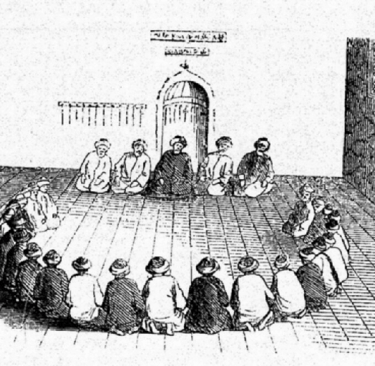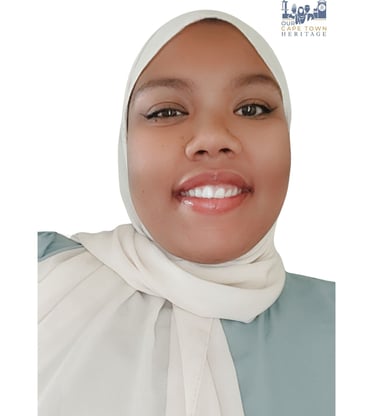PRESERVING CAPE HERITAGE AND CULTURE THROUGH EXPLORING VISUAL ARTS AND EDUCATION
Harmonies of Faith: Thikr Traditions from Cape Town to Johannesburg
Thikr, the Islamic practice of the remembrance of God, holds profound significance within South African Muslim communities. The practice involves the repetition of divine names, phrases, and prayers, creating a rhythmic and meditative experience. The practice of thikr is as diverse as its Muslim population, with distinct regional variations reflecting the unique histories and cultural influences of communities in Cape Town and Johannesburg.
THROUGH YOUR PEN
Waheedah Smith
8/1/20243 min read


The Singing Thikr of Cape Town
Cape Town’s thikr tradition is renowned for its melodic and almost song-like quality, a feature that distinguishes it from other regions. This distinctive style can be traced back to the city’s history of slavery and the blending of cultures that ensued.
Historical Context
The Cape Malay community, one of the earliest Muslim groups in South Africa, was formed by enslaved people brought to the Cape Colony by the Dutch from the Indonesian Archipelago, Madagascar, and East Africa in the 17th and 18th centuries (Shell, 2009). These communities brought with them rich musical traditions that blended with their Islamic practices. The rhythmic and melodic aspects of their heritage naturally merged with their thikr, creating a unique form that sounds more like singing.
Cultural Influence
The Cape Malay thikr often includes the use of traditional instruments such as the dhol (a type of drum) and the ghoema (a barrel-shaped drum), adding a distinctive beat and rhythm to their chants. This musicality is reflective of the community’s broader cultural practices, where music and dance play a significant role in social and religious life (Martin, 1999). The influence of Sufi traditions, which emphasize the spiritual and ecstatic experience of worship through music and dance, is also evident in the Cape Malay approach to thikr (Davids, 2011).
The Thikr of Johannesburg
In contrast, the thikr practices in Johannesburg tend to be more straightforward and less musical. This difference can be attributed to the distinct origins and historical experiences of the Muslim communities in this region.
Diverse Origins
Johannesburg’s Muslim population is more diverse, with significant numbers of Indian, Pakistani, and East African Muslims, many of whom migrated to South Africa during the late 19th and early 20th centuries (Vahed, 2012). These communities brought with them different Islamic traditions and practices. The Indian Muslims, for example, have a strong influence from the Deobandi and Barelvi movements, which have their own specific ways of conducting thikr. However, there is also a very finite group of Muslims in Johannesburg that has descended from Cape Town/Cape Malay muslims and thus very few Muslim communities in Johannesburg, such as Bosmont, Newclare, Eldorado Park, Fietas, etc., engage in similar melodious thikr.
Simplicity and Uniformity
Johannesburg’s thikr is typically characterized by its simplicity and uniformity. The focus is more on the verbal repetition of the names of Allah and other sacred phrases, often in unison and without the accompaniment of musical instruments. This form of thikr is more meditative and less performative, aiming to foster a sense of inner peace and spiritual connection without the external embellishments of melody and rhythm (Tayob, 1995).
The Impact of Regional Histories
The differences in thikr practices between Cape Town and Johannesburg reflect the broader historical and cultural contexts of these regions. Cape Town’s history of slavery and cultural fusion gave rise to a more expressive and musical form of thikr, while Johannesburg’s diverse and later-arriving Muslim communities maintained a more conservative and uniform practice.
To conclude, the variations in thikr between Cape Town and Johannesburg offer a fascinating glimpse into how regional histories and cultural influences shape religious practices. Cape Town’s thikr, with its melodic and rhythmic qualities, stands as a testament to the enduring influence of the city’s unique history and cultural heritage. In contrast, Johannesburg’s more rigorous and meditative thikr reflects the diverse and multifaceted nature of its Muslim community. Both forms of thikr, though different in expression, serve the same purpose: the remembrance and glorification of Allah.
References
Davids, A. (2011). The Afrikaans of the Cape Muslims from 1815 to 1915. Cape Town: University of South Africa Press.
Martin, D. C. (1999). Coon Carnival: New Year in Cape Town, Past and Present. Cape Town: David Philip Publishers.
Shell, R. C.-H. (2009). Islam in Southern Africa: Historical Perspectives. Cape Town: New Africa Books.
Tayob, A. (1995). Islamic Resurgence in South Africa: The Muslim Youth Movement. Cape Town: University of Cape Town Press.
Vahed, G. (2012). Muslim Portraits: The Anti-Apartheid Struggle. Pietermaritzburg: University of KwaZulu-Natal Press.
Moosa, E. (2015). What is a Madrasa? Cape Town: University of Cape Town Press.
Image: Brown cited in Abdul-Hamid, Walid & Hacker Hughes, Jamie. (2015). Integration of Religion and Spirituality Into Trauma Psychotherapy: An Example in Sufism?. Journal of EMDR Practice and Research. 9. 10.1891/1933-3196.9.3.150.




Discover
Contact Us
Our cultural heritage matters
Help us learn and grow by sharing your respectful feedback on our website, exhibitions, social media and more:
Store's Terms and Conditions
